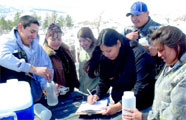IN THIS ISSUE . .
.
Spring 2007
DIRECTOR'S
MESSAGE:
Connecting Investigators and Communities with Research Opportunities
FEATURED
STORY:
Critical Connections
Collaborations among disparate research institutions enhance biomedical research and the nation’s health.
CTSA QUICK TAKES:
Updates on the Clinical and Translational Science Awards
SCIENCE
ADVANCES:
Cholesterol Buster
Physicians uncover a new way of reducing high cholesterol in patients resistant to standard drug treatments.
RESOURCE
BRIEF:
For Understanding Human Disease, the Mouse Is a Knockout
NEWS FROM
NCRR:
People,
Awards, Grants, and New
Developments
Web Exclusives:
National Advisory Research Resources Council Meeting, Director's Statement on the FY 2008 Budget Request, FY 2007 Funding Strategies, Review of Carryover Requests, Funding Opportunities
This e-newsletter links to full content of
the NCRR Reporter quarterly
magazine and to additional Web-exclusive
content. To request a free subscription to
the print magazine, contact
info@ncrr.nih.gov.
You can subscribe, change your subscription
options, or unsubscribe to this
e-newsletter by using the NCRR Reporter
subscriber page on the NIH LISTSERV Web
site.
We encourage you to forward this
e-newsletter to colleagues who may find it
of interest.
DIRECTOR'S MESSAGE:Connecting Investigators and Communities with Research Opportunities
One of the key ways in which NCRR supports biomedical research in all geographic areas across the nation is through the Institutional Development Award (IDeA) program. By funding faculty development and enhanced infrastructure, the program fosters health-related research and improves the competitiveness of investigators at research institutions in 23 states, ranging from Alaska to Vermont and North Dakota to Mississippi, as well as Puerto Rico. Read more.
FEATURED STORY:Critical Connections Collaborations among disparate research institutions enhance biomedical research and the nation’s health.

What do a research program to test water quality on an Indian Reservation in Montana, an effort to identify genes associated with heart disease among the Appalachian people of West Virginia, and a network of high-speed Internet connections linking research centers and primarily undergraduate institutions in Louisiana have in common? They are examples of initiatives funded by NCRR’s Institutional Development Award (IDeA) program, which aims to increase the research capability of states with historically low success rates of obtaining NIH grants. Read more.
CTSA QUICK TAKES:Updates on the Clinical and Translational Science Awards
NIH Clinical Center Collaborates with CTSAs. The NIH Clinical Center—NIH’s clinical research hospital in Bethesda, Md., and the world’s largest clinical research complex—provides unparalleled opportunities for collaborations with NCRR’s Clinical Translational Science Awards institutions. Read more.
SCIENCE ADVANCES:Cholesterol BusterPhysicians uncover a new way of reducing high cholesterol in patients resistant to standard drug treatments.

Patients with homozygous familial hypercholesterolemia (FH), a genetic condition that causes abnormally high levels of "bad cholesterol" in the blood, frequently develop heart disease before their 25th birthdays. Physicians at the University of Pennsylvania have tested a new potential treatment that led to a remarkable 51 percent reduction in cholesterol levels in six homozygous FH patients. Read more.
RESOURCE BRIEF:For Understanding Human Disease, the Mouse Is a Knockout
NIH’s Knockout Mouse Project is aiming to eventually disrupt, or “knock out,” each of the 20,000 or so genes in the mouse genome. Although the project was officially launched last fall, NCRR-supported researchers have long been laying the groundwork to achieve the project’s goals. Read more.
NEWS FROM NCRR:People, Awards, Grants, and New
Developments
Web Exclusives
National Advisory Research Resources Council Meeting.
NCRR’s advisory council will meet on Tuesday, May 22, 2007, on the NIH Campus, in Building 31, 6th floor, conference room 10. The meeting will include presentations on NCRR’s translational programs and other issues. Read more (11KB PDF file, requires free Acrobat Reader).
Director's Statement on the FY 2008 NCRR Budget Request. Dr. Alving updates Congress on the progress that NCRR has made toward helping to transform clinical and translational research since the launch of the NIH Clinical and Translational Science Award (CTSA) program. She also describes how this transformation is creating new energy and opportunities within NCRR and across the NIH. Read more.
FY 2007 Funding Strategies. With the enactment of PL 110-005: Revised Continuing Appropriations Resolution, 2007 on February 15, 2007, the NCRR has funding for the remainder of FY 2007. Under this resolution, specific grant funding guidelines apply. Read more.
Review of Carryover Requests. NCRR funds several grant mechanisms that do not have automatic carryover authority. The grantees funded by these mechanisms must obtain NCRR’s approval before using prior-year unobligated funds. Read
more.
Funding Opportunities:
-
Institutional Clinical and Translational Science Award (U54). NCRR solicits applications for the third round of Clinical and Translational Science Awards, with a deadline of October 24, 2007.
Read more.
-
Continued Development and Maintenance of Software (R01). Biomedical research laboratories increasingly undertake a software development project to solve a problem of interest to that laboratory. These software packages sometimes become useful to a much broader community of users that can include translational and clinical researchers. This program supports the continued development, maintenance, testing, and evaluation of existing software. Read more.
-
National Gene Vector Biorepository and Coordinating Center (P40). This announcement solicits Specialized Centers grant applications from applicant institutions with the goal of providing a biologic storage facility for gene vector materials. Read more.
-
Development of Animal Models and Related Biological Materials for Research (R21). This announcement solicits grant applications from organizations proposing to develop, characterize, or improve animal models for human disease, or to improve diagnosis and control of laboratory animal diseases that may interfere with research. Read more.
-
Developing and Improving Institutional Animal Resources (G20). NCRR encourages the submission of individual animal resource improvement grant applications from biomedical research institutions. The major objective of this program is to upgrade animal facilities for Public Health Service–supported biomedical and behavioral research. Read more.
-
Competitive Continuation of Centers of Biomedical Research Excellence (P20). NCRR invites applications for competing continuation of eligible Centers of Biomedical Research Excellence (COBRE) grants. The objective of the COBRE initiative is to strengthen institutions’ biomedical research infrastructure. Read more.
|

